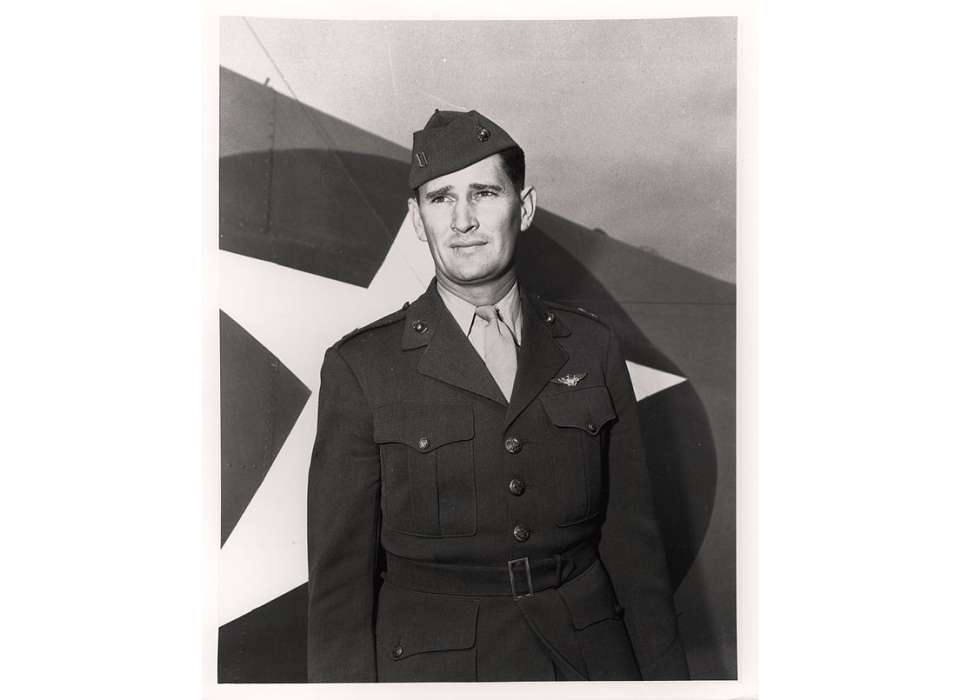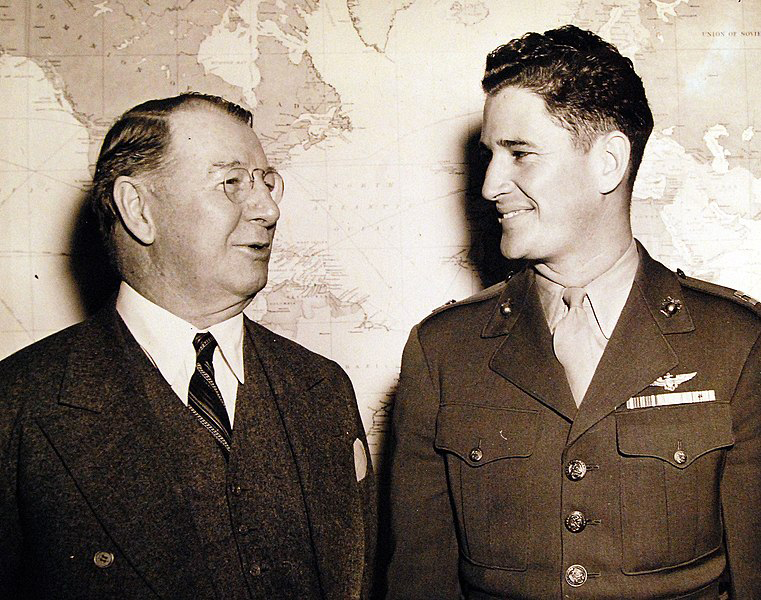Joseph J. Foss was born on April 17, 1915, outside of Sioux Falls, South Dakota and became fascinated with flying at the age of 11 when he saw Charles Lindbergh on tour with his aircraft, the “Spirit of St. Louis”, at an airfield in Renner, South Dakota in 1927. Afterward, Foss reportedly told his father, “I’m going to be bigger than Lindbergh someday.”
After graduating from Washington High School in Sioux Falls, Foss enrolled in the University of South Dakota, where he earned his pilot’s certification, a degree in Business Administration, and served in the South Dakota National Guard. In June 1940, Foss hitchhiked 300 miles to Minneapolis to enlist in the Marine Corps Reserve so he could join the Naval Aviation Cadet program. On March 31, 1941, Foss earned his wings at NAS Pensacola and was commissioned a Second Lieutenant in the Marine Corps. On April 10, 1942, he was advanced to First Lieutenant while serving as a flight instructor at Pensacola. On August 11, 1942, he was promoted to captain at Camp Kearney, California.
After the United States joined World War II, Foss became the executive officer of Marine Fighting Squadron 121 (VMF-121) in October 1942. He and his squadron were deployed to Guadalcanal Island as part of Operation Watchtower. Stationed at Henderson Field, which was regularly attacked by Japanese air, sea, and ground forces, Foss and his airmen saw almost daily action.
During his first 12 days in the Pacific Theater, Foss shot down 16 enemy aircraft. Only four days after arriving in Guadalcanal, on October 13, 1942, Foss engaged in his first dogfight and scored his first victory, a Japanese Mitsubishi A6M Zero fighter. Five days later, on October 18, 1942, Foss led his squadron in an attack, shooting down three Zeros. On October 25, he shot down five Japanese fighters in two missions becoming the Marine Corps’ first “ace in a day.” Between October 1942 and January 1943, Foss scored 26 confirmed victories, tying the record set by Eddie Rickenbacker in World War I.
After suffering from a bad case of malaria, Foss returned to the United States in March 1943 and received the Medal of Honor from President Roosevelt in May. He returned to the Pacific Theater in February 1944 to lead Marine Fighter Squadron 115 (VMF-115). Although Foss did not shoot down any additional enemy aircraft, he met his childhood hero, Charles Lindbergh. Eight months into his second tour, Foss again suffered from malaria and returned to the United States.
After the war, Foss continued to serve in the South Dakota Air National Guard and eventually rose to the rank of Brigadier General. In 1954 he was elected governor of South Dakota and serving for two terms. He also served as the first commissioner of the American Football League, starred in the ABC’s series American Sportsman, and was elected president of the National Rifle Association for two terms starting in 1988. Joseph Foss died on January 1, 2003, from complications resulting from a stroke and is buried in Arlington National Cemetery.
Medal of Honor Citation:
For outstanding heroism and courage above and beyond the call of duty as Executive Officer of a Marine Fighting Squadron, at Guadalcanal, Solomon Islands. Engaging in almost daily combat with the enemy from October 9 to November 19, 1942, Captain Foss personally shot down 23 Japanese aircraft and damaged others so severely that their destruction was extremely probable. In addition, during this period, he successfully led a large number of escort missions, skillfully covering reconnaissance, bombing and photographic planes as well as surface craft. On January 15, 1943, he added three more enemy aircraft to his already brilliant successes for a record of aerial combat achievement unsurpassed in this war. Boldly searching out an approaching enemy force on January 25, Captain Foss led his eight F4F Marine planes and four Army P-38s into action and, undaunted by tremendously superior numbers, intercepted and struck with such force that four Japanese fighters were shot down and the bombers were turned back without releasing a single bomb. His remarkable flying skill, inspiring leadership and indomitable fighting spirit were distinctive factors in the defense of strategic American positions on Guadalcanal.
Jennifer Popowycz, PhD
Jennifer Popowycz, PhD is the Leventhal Research Fellow at The National WWII Museum. Her research focuses on the Eastern Front and Nazi occupation policies in Eastern Europe in World War II.
Cite this article:
MLA Citation:
APA Citation:
Chicago Style Citation:








![Max Fuchs, New York City cantor, sings as Rabbi Sydney [sic] Lefkowitz, Richmond, VA, conducts the first Jewish services from Germany.](/sites/default/files/styles/max_650x650/public/2025-10/image1.jpg)

